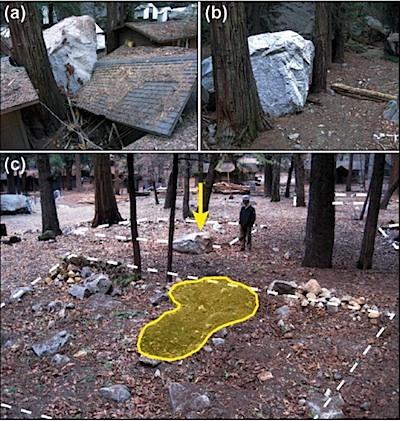
Rockfall hazard and risk in Yosemite Valley's Curry Village. (a) Cabin damage resulting from an October 2008 rockfall. (b) The same area following removal of more than 200 cabins in
2013. (c) Successful mitigation of rockfall risk. Dashed white lines indicate footprints of removed cabins. The yellow arrow identifies an approximately 1-cubic- meter boulder that fell in February 2014, and the yellow shaded area shows the impact crater from this boulder within the footprint of a former cabin/NPS
As rare as a vacant bed in the Yosemite Valley can be during the high summer season, a decision by Yosemite National Park officials to reduce housing in the Curry Village area very possibly saved lives.
The park has a long history of rockfalls -- "925 rockfalls between 1857 and 2011, resulting in 15 fatalities; 85 injuries, and extensive damage to buildings, roads, and trails," according to an article in the latest issue of EOS, published by the American Geophysical Union.
A massive landfall in the Yosemite Valley in October 2008 convinced park officials to close 233 visitor accommodations, or roughly one-third of the available housing in Curry Village. Also closed were a shower house, restrooms, and 43 concessioner employee housing units.
That decision paid off this past February, when a rockfall rained boulders down onto areas where cabins once stood.
In the early morning of February 2014, a rockfall sent boulders into Curry Village, but this time, there were no longer buildings there to be affected. A boulder with a volume of about 1 cubic meter impacted within the footprint of a former wooden cabin and then came to rest within the foundation of another. Had these cabins been standing, they would have been extensively damaged, and had they been occupied, there almost certainly would have been injuries and perhaps even fatalities.
While the actions following the 2008 rockfall reduced by 95 percent the risks of park visitors being hurt in a rockfall, compared to 2008 levels, the authors -- Yosemite geologist Greg Stock and USGS geologist Brian D. Collins -- note, "it is not possible to completely eliminate risk from rockfalls."

 Support Essential Coverage of Essential Places
Support Essential Coverage of Essential Places






